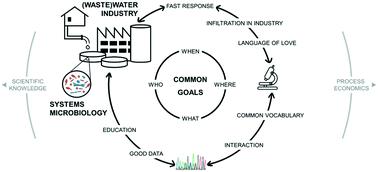当前位置:
X-MOL 学术
›
Environ. Sci.: Water Res. Technol.
›
论文详情
Our official English website, www.x-mol.net, welcomes your feedback! (Note: you will need to create a separate account there.)
Plant-wide systems microbiology for the wastewater industry
Environmental Science: Water Research & Technology ( IF 5 ) Pub Date : 2021-06-11 , DOI: 10.1039/d1ew00231g Marta Cerruti 1 , Bing Guo 1, 2, 3 , Robert Delatolla 4 , Nadieh de Jonge 5, 6 , Aleida Hommes - de Vos van Steenwijk 7 , Paul Kadota 8 , Christopher E. Lawson 9, 10 , Ted Mao 11 , Margreet J. Oosterkamp 12 , Fabrizio Sabba 13 , Mikkel Stokholm-Bjerregaard 14 , Ian Watson 15 , Dominic Frigon 2 , David G. Weissbrodt 1
Environmental Science: Water Research & Technology ( IF 5 ) Pub Date : 2021-06-11 , DOI: 10.1039/d1ew00231g Marta Cerruti 1 , Bing Guo 1, 2, 3 , Robert Delatolla 4 , Nadieh de Jonge 5, 6 , Aleida Hommes - de Vos van Steenwijk 7 , Paul Kadota 8 , Christopher E. Lawson 9, 10 , Ted Mao 11 , Margreet J. Oosterkamp 12 , Fabrizio Sabba 13 , Mikkel Stokholm-Bjerregaard 14 , Ian Watson 15 , Dominic Frigon 2 , David G. Weissbrodt 1
Affiliation

|
The wastewater treatment sector embraces mixed-culture biotechnologies for sanitation, environmental protection, and resource recovery. Bioprocess design, monitoring and control thrive on microbial processes selected in complex microbial communities. Microbial ecology and systems microbiology help access microbiomes and characterize microorganisms, metabolisms and interactions at increased resolution and throughput. Big datasets are generated from the sequencing of informational molecules extracted from biomasses sampled across process schemes. However, they mostly remain on science benches and computing clusters, without reaching the industry in a clear engineering objective function. A bilateral bridge should actionize this information. As systems microbiologists, we miss that engineering designs and operations rely on stoichiometry and kinetics. The added-value provided by microbial ecology and systems microbiology to improve capital (CAPEX) and operating expenditures (OPEX) needs to be addressed. As engineers, we miss that microbiology can be provide powerful microbial information on top of physical–chemical measurements for quantitative process design (e.g., nutrient removal systems) with detailed scientific description of phenomena inside microbiomes. In this perspective article, we allied academia and industry to address the state of shared knowledge, successes and failures, and to establish joint investigation platforms. Our roadmap involves three milestones to (i) elaborate an essential list of microbiological information needed to implement methods at the process line; (ii) characterize microbiomes from microorganisms to metabolisms, and shape conceptual ecosystem models as primer for process ecology understanding; (iii) bridge engineering and mathematical models with an analytical toolbox for fast- vs. high-throughput analyses to discover new microbial processes and engineer assemblies. We praise for a harmonized “language of love” (incorporating common vocabulary, units, protocols) across the water and environmental biotechnology sector to team up mindsets for a sewer- and plant-wide integration of systems microbiology and engineering.
中文翻译:

废水行业的全厂系统微生物学
废水处理部门采用混合培养生物技术,用于卫生、环境保护和资源回收。生物过程设计、监测和控制在复杂微生物群落中选择的微生物过程中蓬勃发展。微生物生态学和系统微生物学有助于访问微生物组并以更高的分辨率和吞吐量表征微生物、代谢和相互作用。大数据集是根据从跨工艺方案采样的生物质中提取的信息分子的测序生成的。然而,它们大多停留在科学台和计算集群上,没有以明确的工程目标函数进入行业。双边桥梁应该将这些信息付诸行动。作为系统微生物学家,我们忽略了工程设计和操作依赖于化学计量学和动力学。需要解决微生物生态学和系统微生物学为改善资本 (CAPEX) 和运营支出 (OPEX) 提供的附加值。作为工程师,我们错过了微生物学可以在定量过程设计的物理化学测量之上提供强大的微生物信息(例如,营养物去除系统),对微生物组内部的现象进行详细的科学描述。在这篇透视文章中,我们联合学术界和工业界来解决共享知识、成功和失败的状况,并建立联合调查平台。我们的路线图涉及三个里程碑,以 (i) 详细说明在生产线上实施方法所需的微生物信息的基本清单;(ii) 表征从微生物到代谢的微生物组,并塑造概念生态系统模型作为过程生态学理解的基础;(iii) 桥梁工程和数学模型,带有快速与快速分析工具箱。高通量分析以发现新的微生物过程和工程组装。我们赞扬在整个水和环境生物技术领域采用统一的“爱的语言”(包含通用词汇、单位、协议),以整合下水道和工厂范围内系统微生物学和工程整合的思维方式。
更新日期:2021-07-09
中文翻译:

废水行业的全厂系统微生物学
废水处理部门采用混合培养生物技术,用于卫生、环境保护和资源回收。生物过程设计、监测和控制在复杂微生物群落中选择的微生物过程中蓬勃发展。微生物生态学和系统微生物学有助于访问微生物组并以更高的分辨率和吞吐量表征微生物、代谢和相互作用。大数据集是根据从跨工艺方案采样的生物质中提取的信息分子的测序生成的。然而,它们大多停留在科学台和计算集群上,没有以明确的工程目标函数进入行业。双边桥梁应该将这些信息付诸行动。作为系统微生物学家,我们忽略了工程设计和操作依赖于化学计量学和动力学。需要解决微生物生态学和系统微生物学为改善资本 (CAPEX) 和运营支出 (OPEX) 提供的附加值。作为工程师,我们错过了微生物学可以在定量过程设计的物理化学测量之上提供强大的微生物信息(例如,营养物去除系统),对微生物组内部的现象进行详细的科学描述。在这篇透视文章中,我们联合学术界和工业界来解决共享知识、成功和失败的状况,并建立联合调查平台。我们的路线图涉及三个里程碑,以 (i) 详细说明在生产线上实施方法所需的微生物信息的基本清单;(ii) 表征从微生物到代谢的微生物组,并塑造概念生态系统模型作为过程生态学理解的基础;(iii) 桥梁工程和数学模型,带有快速与快速分析工具箱。高通量分析以发现新的微生物过程和工程组装。我们赞扬在整个水和环境生物技术领域采用统一的“爱的语言”(包含通用词汇、单位、协议),以整合下水道和工厂范围内系统微生物学和工程整合的思维方式。


























 京公网安备 11010802027423号
京公网安备 11010802027423号